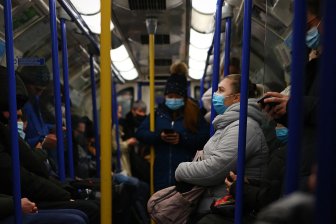Several municipalities in Elgin and Oxford counties will have capacity restrictions reintroduced this week in a bid to curb rising rates of COVID-19 cases in the region.
Aylmer, Bayham, Blandford-Blenheim, Malahide, Norwich, South-West Oxford, Tillsonburg and West Elgin will have capacity limits reinstated as of 12:01 a.m. on Dec. 2, Southwestern Public Health (SWPH) officials said Monday. .
The eight municipalities, almost half of the municipalities in the region, says the health unit, are being the target, since they have weekly incidence rates of more than 80 cases per 100,000 people and / or complete vaccination rates of less. 80 percent for residents 12 and older. .
The stricter capacity limits will be on par with the measures implemented in Stage 3 of the province’s reopening plans. They will remain in place for at least six weeks, until January 10, 2022, the health unit said.
Read more:
Omicron variant boosts G7 health emergency meeting, including Canada
As a result of the reintroduced limits, capacity in restaurants and bars will be limited to 50 percent indoors, with customers sitting at different tables and physically distanced, the health unit said.
A 50 percent indoor capacity limit will also be implemented for sports and recreational facilities, personal care services, indoor recreational facilities, meeting and event spaces, concert halls, theaters and cinemas, the health unit said.
The region’s medical health officer, Dr. Joyce Lock, is issuing a letter of instructions requiring that weddings, funerals and religious services put a meeting limit at 50 percent.
“The Letter of Instruction does not modify the provincially established limits of 25 people to meet indoors or 100 people to meet outdoors, although people are strongly advised to limit indoor gatherings for their own safety,” the unit said. health in a press release.
In a statement, Lock said that cases in the Elgin-Oxford region have been steadily increasing, requiring the reintroduction of capacity limits.
“Our test positivity rate, our number of cases per 100,000 people and the pressure on our hospitals indicate that steps must be taken to stop this increase,” Lock said.
“These high case counts are testing local healthcare providers and disrupting both workplaces and schools.”
At least 691 cases and seven deaths related to COVID-19 were reported in SWPH’s jurisdiction between October 29 and November 29. In comparison, 388 cases and five deaths were reported in the region between September 29 and October 29, according to data from the health unit.
As of Monday, 211 cases were active in Elgin-Oxford, up from 162 a week earlier, 159 two weeks earlier and 129 three weeks earlier. Of the 211 active cases in the region, 40 were in Tillsonburg, 36 in Woodstock, 35 in St. Thomas and 29 in Aylmer.
Read more:
COVID-19: Outbreak Declared at Fanshawe College Residence as Western Outbreak Grows
“We continue to see the trend that the majority of COVID-19 patients requiring hospitalization are not vaccinated,” said Perry Lang, president and CEO of Woodstock Hospital in a statement. “For this reason, I urge everyone who has not yet done so to get vaccinated.”
At least 16 COVID-19 patients were in the care of hospitals in SWPH’s jurisdiction as of Sunday, with 11 at St. Thomas Elgin General Hospital (STEGH) and five at Tillsonburg District Memorial, according to provincial data.
As of Sunday, the STEGH intensive care unit was operating at 125 percent capacity and was treating five COVID-19 patients, according to provincial data.
Earlier this month, STEGH bosses described a “desperate situation” at the hospital as the number of cases increased in the region.
“We have reached our capacity to care for critically ill patients and our hospital is operating above capacity, which are the direct result of COVID-19,” said Dr. Waleed Chehadi, the hospital’s chief of staff, at the time. .
Read more:
Omicron COVID-19 variant poses ‘very high’ global risk, WHO warns
The overall vaccination rate for the region is 74.9% for the first doses and 72.6% for both doses. The health unit points out that the figure includes all residents.
The Aylmer area has one of the lowest vaccination rates in Ontario, as well as one of the highest test positivity rates in the province, according to data from the nonprofit health research group ICES.
As of October 31, only 52 percent of people 12 and older on N5H, Canada Post’s forwarding sorting area made up primarily of Aylmer, had received at least one dose. Updated figures are expected for December 10, says ICES.
The region with the second lowest first dose rate, 59.5 percent, was N0J, spanning Elgin and Oxford counties, covering rural areas outside of Ingersoll, Tillsonburg and Woodstock. Part of the FSA is under the jurisdiction of a neighboring health unit.
According to weekly test data published by ICES, N5H had the third highest weekly percentage positivity rate in Ontario as of November 10, the most recent data available, at 14.81%.
P0J, from the Timiskaming Health Unit, was the highest, 16.27%, while L9J, from the Simcoe Muskoka District Health Unit, ranked second with 15.22%.
Throughout the pandemic, Aylmer has recorded at least 771 COVID-19 cases, a cumulative rate of cases equivalent to 10,291 per 100,000 people. In contrast, Woodstock, which has had 1,195 cases during the pandemic, the most of any municipality in the SWPH area, has a cumulative rate of 2,921 cases per 100,000.
See link »
© 2021 Global News, a division of Corus Entertainment Inc.
Reference-globalnews.ca


